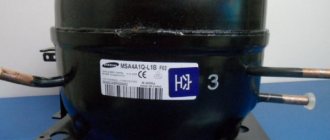Horizontal or vertical?
When transporting, the best option is to transport the refrigerator while standing. In this case, the oil from the compressor will not penetrate other components of the system, will not settle on the walls and mix with sediment and contaminants.
You can transport equipment in a lying position. But you must follow the rules for transporting a refrigerator. In this case, after transportation it cannot be turned on immediately. You need to let it sit for some time. We talked about this in more detail in the article “Why you can’t immediately turn on the refrigerator after delivery, transportation, transportation.” We recommend reading it; it will not be unnecessary information.
Bottom line
You can carry a refrigerator, but during transportation you must take into account the rules for placing it in the body. The best option for loading such equipment is to maintain its normal operating position. I do not recommend delivering the refrigerator in a lying position, since many manufacturers refuse warranty service after such procedures. If transportation is carried out in accordance with all the rules and regulations, then breakdowns are unlikely.
Video: packing a refrigerator - preparing for moving into an apartment
Refrigerator packaging | Preparing for an apartment move
Watch this video on YouTube
Video: how to transport a refrigerator
How to transport a refrigerator?
Watch this video on YouTube
Do you want to understand better than others?
- How to properly transport a refrigerator in a car? - Lying down? Standing? On your side? Basic rules of transportation! — It is necessary to transport the refrigerator in compliance with the rules, since the incorrect position of the unit during transportation can potentially cause breakdowns...
- How to properly transport a refrigerator when moving? - Lying down? Standing? On your side? — It is necessary to transport the refrigerator in compliance with the rules, since the incorrect position of the unit during transportation can potentially cause breakdowns...
- How to properly transport a refrigerator in a car? Rule #1 when transporting! — It is necessary to transport the refrigerator in compliance with the rules, since the incorrect position of the unit during transportation can potentially cause breakdowns...
- On which side should the Indesit refrigerator be transported? — Transportation of a new refrigerator Rules for transporting a new refrigerator from a store depend on the manufacturer’s recommendations and the requirements of the service center. They need to be clarified with...
- How to fix a refrigerator compressor. How to properly transport and carry a refrigerator - Features of transporting a refrigerator Difficulties in transporting a refrigeration unit lie in the presence of refrigerant in the cooling system. Even the slightest leak will...
Transporting a new refrigerator
The rules for transporting a new refrigerator from the store depend on the manufacturer’s recommendations and the requirements of the service center. They need to be clarified with a representative, consultant, manager or seller. Check if they match those specified in the instructions.
If it turns out that you transported the equipment incorrectly, there is a risk of losing the warranty. If your refrigerator is damaged due to improper transportation, you will be denied service. There is a 99% chance that the warranty will be voided.
If the seller delivers the refrigerator or freezer to you, check exactly how they will transport it. Small shops may not have a truck, rigging, or other necessary equipment. If the refrigerator is damaged during delivery and you do not notice, the blame remains with you.
Transporting a new refrigerator in a box
In many cases, after purchasing, it makes more sense to deliver the refrigerator to your home yourself, rather than with the help of transport companies. This is mainly due to the reduction of financial costs for the buyer. Difficulties rarely arise here. In the store, the unit is wrapped in special packaging, so there is no need to additionally protect it from possible mechanical damage that may occur during transportation. In addition, in most cases, the packaging of the equipment contains special markings, by which a person can determine which side of the refrigerator can be placed on and which not. Here are general recommendations for transporting the unit. The buyer just needs to stick to them. This will help bring the refrigerator home in good condition.
Note! Some equipment manufacturing organizations refuse to fulfill warranty obligations if it turns out that the refrigerator was transported in a horizontal position. It is better to clarify this question with the sellers in advance.
Transporting an old refrigerator
There are no specific rules for transporting an old or used refrigerator. it all depends on the situation:
- What vehicle are you transporting in?
- In what position is the refrigerator located?
- Is he well prepared for the move?
According to statistics from service centers, after self-transportation, 30% of refrigerators are found to have faults. In 90% of cases, this is due to improper transportation of the refrigerator during the move, preparation and mechanical damage. The remaining 10% are hidden damage that appeared during transportation.
How to pack a refrigerator when moving
We recommend reading:
How to transport a refrigerator in a car
There are several packaging options, each of which will be considered separately. But first, let’s note the general rules that you should first follow:
- If your refrigerator has sharp edges, cover them with bubble wrap. Apply film to these sharp corners and tape;
- Attach the power cord to the refrigerator radiator grille or to special mounts, if available;
- If the refrigerator's legs are potentially sharp and could damage the floor when carried, try to soften them. A rag that can be wrapped around them is suitable for this;
- Secure the door securely so that it does not open during transport.
After this, you can proceed directly to packaging the device.
Factory box
The best option for packaging any household appliance is the original box. If you still have one, just put the refrigerator in it when you move.
note
It often happens that the original box is present, but its contents necessary for safe transportation are missing. In this case, before loading the refrigerator into the box, you can wrap it in a blanket, blanket or other soft cloth. This will reduce the likelihood of damage to the refrigerator body upon impact.
Shipping cardboard
It is better to use large sheets of shipping cardboard. It’s easy to pack a refrigerator in them - wrap them in sheets of cardboard and then wrap the cardboard with the refrigerator using packaging film.
note
If the refrigerator is tall and heavy, it is better not to completely wrap it with film and leave some areas that will be convenient for movers to grab when carrying it.
Styrofoam
If shipping cardboard is not available, use polystyrene foam to pack the refrigerator. Using polystyrene foam and tape, corners of equipment that are at risk of being damaged, for example, during transportation in a stairwell against walls, are protected.
There is no need to completely wrap the refrigerator with foam plastic - this will require a lot of material and will complicate the work of the loaders. To prevent the refrigerator from being damaged directly during transportation in the car, wrap it in a blanket, rug or securely fix it already there.
Foam rubber
Also quite suitable for packing a refrigerator. But it is recommended to choose foam rubber no thinner than 40 mm in order to reliably protect the device from possible damage. Wrap the refrigerator with foam rubber and packaging film, paying attention to areas of possible damage.
Preparing to move
Before transporting the refrigerator you must:
- Remove all products from it;
- Defrost the refrigerator completely;
- Empty the condensate tray (located above the compressor);
- Remove (or protect) the legs or casters.
A container for water flowing from the walls is located above the refrigerator motor. It is usually hidden behind the back panel. It will have to be dismantled. After the moisture tray has drained, replace the panel.
Most refrigerators stand on adjustable legs or wheels. Dismantle them to avoid damage during handling and transportation. Usually they just unscrew (counterclockwise). In some models, the legs are located on an overhead plate. Remove it by unscrewing the mounting screws.
Advice
Before transporting, wash the refrigerator compartments. Clean the rear compartment where the compressor is located from dust and dirt. Such prevention will not be superfluous.
Packing and fixing
Some refrigerator models have latches for shelves and drawers. They are used to transport the unit. You can fix the internal removable parts with their help.
It is better to remove all removable shelves, drawers, trays and transport them separately. This way you will slightly reduce the weight of the refrigerator, making it easier to carry and install. When transporting the shelves, place them between each other with cardboard, cloth or rags. Pack boxes and trays to protect them from scratches and impacts.
Secure the doors in the closed position with tape. Some models have special fasteners included in the kit. They are installed instead of standard hinges, or together with them.
Installation location of refrigerator door latches
Advice
To move the refrigerator around the house or apartment, place a large piece of thick fabric, a blanket, etc. under it. The floor covering will not be scratched or torn, the refrigerator can be pulled along the floor rather than carried.
If there is original packaging, use it to protect the refrigerator. If not, wrap it in bubble wrap to protect it from scratches. Fabric, cardboard, foam rubber, and any available packaging material are also suitable.
Pay special attention to the compressor and copper pipes. Some models have mounting brackets on the refrigerator motor. With their help, the compressor is attached to the housing for transportation. If there are no brackets, cover the motor with rags and rags, cardboard, and foam rubber.
The refrigerator compressor must be secured in such a way as to avoid vibration during transportation. Be careful not to damage the copper capillary tubes coming from it. do not allow distortions and deformations.
Important
Some people recommend using foam to secure the compressor. This is absolutely forbidden to do! When it hardens, it expands and can:
- Distort the refrigerator compressor;
- Damage copper tubes;
- Break the tightness of the connections;
- Deform the side walls.
Position No. 3 – lying position
It is about this position that a lot of questions arise - from the point of view of the average person, this is the simplest option. However, this situation requires knowledge of several nuances:
- The refrigerator should lie on the side opposite the side where the compressor tubes exit - they should face up.
- Do not place equipment on the back wall - the closing grille may bend, resulting in damage to the compressor and fasteners. In the future, the refrigerator will operate with rattling noise.
- Before placing it in the car, it is necessary to secure the compressor well - packaging materials, tape, etc. will do. After installation in a new location, they must be removed.
- Transportation on the door is also prohibited - the weight of the unit during transportation can deform the handle and the door itself and break the seal.
If after transportation there are changes in the operation of the refrigerator (extraneous sounds are heard, incomplete freezing, etc.), you should turn it off and call a technician.
Rules for transporting a refrigerator lying on its side
If it is not possible to transport the refrigerator while standing, you can transport it lying on its side. In this case, oil from the compressor must not be allowed to enter the condenser. During transportation, the refrigerator must be placed on its side so that the discharge tube is directed upward.
The instructions sometimes indicate on which side the refrigerator can be transported. “Left” and “right” are determined when you look at the front of the unit, not the back.
The instructions say that the refrigerator can be transported on its left side.
The discharge tube is the one that runs from the compressor to the condenser - heat exchanger (radiator) at the back of the refrigerator. If you cannot see their connection, read the next section.
Lying on your side (horizontal position)
Now let’s look at the remaining cases when you need to transport the refrigerator yourself, for example, when moving - how to do this correctly? And here there are several options:
- transport according to all the rules, that is, call specialists who will pack it themselves, correctly remove it from the entrance, transport it and bring it in;
- pack the refrigerator yourself and rent transportation on a gazelle with a suitable side height;
- do everything yourself at your own peril and risk.
The question arises: is it possible and how to transport a refrigerator lying down?
Many manufacturers impose a ban on the tilt angle of the refrigerator during transportation exceeding 40 degrees from the vertical, that is, they void the warranty. But experts know that it is still possible to transport a refrigerator in a horizontal position .
The reason for breakdowns and malfunctions due to such transportation is that people cannot correctly determine the side on which the refrigerator can be placed, and some generally believe that there is no difference between the sides. However, it exists and is as follows.
In older models of refrigerators, at the bottom of the back side there is a container in which the compressor is placed. It floats in machine oil. The most common malfunction is mixing of oil with refrigerant, when it enters the discharge tube and is propelled by freon under pressure further through the system.
In modern models, the container may not be visible, covered with a panel, but the principle remains the same. It also happens that the compressor is on spring suspensions, which should soften vibrations. But if transported incorrectly, they themselves may be damaged.
In addition, the entire rear part , including the cooling grille, is quite vulnerable . The grille, along with the thermal insulation, can be damaged by the refrigerator's own weight. It is also possible that pipes may break and improper distribution of refrigerant and oil in the system.
Therefore, placing the refrigerator horizontally backwards is strictly prohibited.
also forbidden to place the refrigerator horizontally forward, that is, on the door . In older models, a protruding handle protects against such an incorrect step. The prohibition is due to the vulnerability of the door fastenings, as well as the high probability of improper mixing of oil and refrigerant.
There is only one side on which it is permissible to place the refrigerator, and the risk of oil getting into the circuit tubes in this position is minimal: most of the oil will remain in the container, and what leaks out will flow back when the refrigerator is returned to the vertical position.
It is necessary to prevent oil from entering the discharge tube so that when the compressor increases pressure, the refrigerant does not push it further along the circuit. This means that when transported on its side, it should be on top .
If you are transporting your refrigerator, a day before transportation, determine the position of the discharge tube with the device running. If it was unplugged, you need to wait at least 15 minutes for the temperature difference on the rear grill to become noticeable. In a working refrigerator, it will be warm, but there is one tube that is hotter than the rest - freon gives off heat in it.
Important: the discharge tube can be very hot, touch it carefully!
The side on which the refrigerant injection pipe passes must be at the top when transported in a horizontal position. Usually it coincides with the side on which the door is attached. This is what the refrigerator should look like:
Attention: There are models of refrigerators in which all the tubes go on one side. This can be seen when looking at the rear. In this case, the side along which the tubes run should also be the top.
How to determine the input and output of a compressor
There are two options for compressors for household refrigerators. The inlet and outlet of the refrigerant line can be located:
- On the one side;
- From opposite sides.
Compressor with capillary tubes located on one side
Compressor with opposite arrangement of freon tubes
In the first case, the refrigerator must be transported lying on its side so that both tubes are directed upward. In the second, you need to determine the inlet and outlet. Some compressors have markings on the housing or stickers:
- "Outlet", arrow in the direction from the compressor: copper tube going to the condenser;
- “Inlet”, “Suction Connector”, arrow in the direction of the compressor (no label): indicate the tube coming from the evaporator.
If there are no markings on the refrigerator motor, you can determine the position of the tubes yourself. Turn on the refrigerator (the doors should be closed) and check the temperature of the copper tubes with your hand once every half a minute to a minute. The tube that will heat up the most goes from the compressor to the condenser.
How to find out by the position of the freon outlet tube whether it is possible to transport a refrigerator lying on its side
Freon circulates through the cooling system as follows: from the compressor in gaseous form it is sent to the condenser and there it becomes liquid. Along the way it gives off heat. If you carefully feel the tubes at the back wall, one of them will be hot. If you are forced to lay down the refrigerator, then this tube must be directed upward.
In some devices, the outgoing and incoming tubes are placed on one side - then there is no need to look for an exit
How to transport a refrigerator in a car
Is it possible to transport a refrigerator lying down in a car? Yes, you just need to decide on the method of transportation. There are three options:
- On the roof;
- In the back seat;
- In the trunk.
If you intend to transport the unit on a roof, secure it properly. Avoid sudden braking, accelerating and turning. It is best to transport the refrigerator lying down, but you can also stand up, securing it thoroughly (but not as in the photo).
Improper transportation of a poorly secured refrigerator while standing on the roof of a car.
Carrying in the back seat is the worst option. With this method of transportation, the refrigerator will be partially outside, the door will be open. visibility in the side rearview mirror will be difficult.
When transporting a refrigerator in the cabin, the car will take up a lot of space on the lane, and maneuverability will decrease. If there are no options, then position the unit so that the lower compartment with the compressor is inside the car.
Transporting a refrigerator in a passenger car.
Transporting a refrigerator in the trunk of a car is the best way. The only problem is that visibility through the rearview mirror may be difficult. When transporting in this way, place the refrigerator with the compressor facing forward in the direction of travel.
If the refrigerator does not fit in the trunk (this is usually the case with sedans), secure it with rigging straps. If, when placed parallel to the direction of travel, the unit does not lie stable, you can turn it diagonally (see photo).
Important
Regardless of the method of transportation, the refrigerator must be secured. Pay special attention to protecting corners, door hinges, door handles and the condenser (heat exchanger).
Features of horizontal transportation of the refrigerator (on its side)
Now we will look at other cases when it is necessary to transport a used device somewhere. You can do this as follows:
- call specialists who can pack, secure and deliver equipment in accordance with all the rules;
- pack the refrigerator yourself and call a cargo taxi;
- transport without specialized equipment.
Most people do not have the opportunity to load equipment into a Gazelle with high sides and locks for vertical transportation - such a vehicle must be ordered. At the same time, manufacturers categorically prohibit transporting the device on its side, but this is still possible if certain nuances are observed.
If you cannot determine the correct side, it is better to transport the refrigerator vertically
The main reason for failure is that inexperienced users cannot correctly determine the side on which horizontal transport is allowed. Some people are even of the opinion that there is no difference between the parties.
The design of outdated models provides for free space at the bottom where the compressor is installed. There it will be mixed by machine oil. The malfunction occurs because refrigerant enters through the tubes.
In modern refrigerators, upon external inspection, it is impossible to notice the box for the compressor, but still there is one behind the panel. However, this does not violate the basic principle of its design. On some models, the compressor is supported by special springs, which are supposed to soften shocks, but if transported incorrectly, they also fail.
Refrigerator interior
The “weak” point of the device is its entire back side along with the cooling grille, because it is also subject to damage, as is the thermal insulation under the weight of the entire structure. Sometimes the integrity of the system tubes may be compromised.
Do not place the refrigerator on the door. If in older models a protruding handle protected against such an error, now it is often missing. The ban is associated with the fact that the door structure suffers during transportation, and mixing of oil and refrigerant can also occur.
It turns out that the refrigerator can only be laid on one side (as shown in the photo) - then the oil does not flow into the tubes, so the risk of breakage is minimized.
It is necessary to prevent machine oil from getting into the discharge pipe in advance - during transportation it should be on top. If you are going to transport equipment, then you need to determine the location of the discharge pipe 24 hours in advance while the device is operating.
This is what the refrigerator should look like if transported horizontally
When turning off the power to the refrigerator, wait about 20 minutes to notice the temperature difference between the racks. If the device is working properly, the discharge pipe will be hot. It is worth noting that in most models this pipe is located on the same side where the door is attached.
Find out what the temperature in the refrigerator should be in a special article on our portal.
Loading and transportation in a truck
If the refrigerator is loaded horizontally or at an angle, follow the same rule as when transporting it lying on its side: the discharge tube from the compressor to the condenser should be positioned vertically and “look” up.
It is convenient to use a special cart with two wheels for loading. With its help you can transport any large equipment and furniture. If there is no cart, you will have to do everything manually.
When transporting equipment, it is better to use pallets. It is convenient to tighten them with a special hook. Pallets are convenient for moving cargo around the body. They are especially convenient if a car is used for loading and unloading.
If you transport the refrigerator vertically, its center of mass will be located at the bottom. The risk of overturning when turning, accelerating or braking is minimal. But it is better to secure it to the floor, pallet or wall using a rigging rope or sling.
Refrigerator mounted in a truck.
The basics of transporting a refrigerator horizontally: is this position dangerous?
However, if you follow the following simple rules, the risks of damage to the units and components of the refrigerator will be minimized:
- When delivery is not provided in your locality, and you have purchased a new household appliance, you need to carefully inspect the packaging of the refrigerator. It must indicate in what position the purchased unit should be during transportation.
- In the store you can study the instructions, which indicate in detail which side is best to lay household appliances. Determine which tube from the compressor the freon comes out of; it should be the one that faces up when you lay down the refrigerator.
- Place the unit with the door hinges facing upward, as they may be damaged when loading or unloading the unit. Be sure to secure the compressor with bolts (they usually come with the device).
The optimal position for moving refrigerators is vertical, but it is important to secure it carefully/
When transporting the device in a car, remember that the lying position is dangerous for the refrigerator. There is a high risk of freon and oil leaking from the compressor. The device will not only stop freezing, but may not start at all.
Transporting a refrigerator in a trailer
There are two ways to transport a refrigerator in a trailer: standing or lying down. When transporting vertically, the refrigerator must be secured with slings or ropes. At the same time, it will interfere with the view from the rearview mirror in the cabin.
When transported horizontally in a trailer, the refrigerator may not fit. If transported in a standing position, it must be secured with rigging along the direction of the vehicle so that it does not fall out through the tailgate.
You can secure it across the trailer with ropes or slings, or place something (boxes, pieces of furniture, boxes). The unit must not move during transport. It is better to place it closer to the car. If he stands behind the trailer, due to the overweight, the lock can be torn off the tow bar.
If the refrigerator fits completely into the trailer, place it so that it rests against the wheel arch and one of the sides. Secure it in this position with slings, ropes, or other weights (see photo).
Transporting a refrigerator in a trailer. The unit is secured on the sides using another weight.
What is the best way to transport a refrigerator: lying down, tilted or standing
Without knowing the nuances of the structure of this unit, you wouldn’t even think that, in fact, this colossus is very afraid of transportation. Box and box, what's so complicated about that? And why is it written in all the instructions that transporting the refrigerated cabinet is possible only in a vertical state and in no other way? Is it possible to transport a refrigerator simply lying in the trunk of a car?
But this task is not so easy to accomplish: some models of refrigerated cabinets are two meters high. They are not as easy to install in a trailer or pickup bed
Do not rush to dismiss the instructions: they are written based on bitter experience. If you carefully study the design of the unit, then, in principle, you can find a position that will allow you to place it on the side or transport it in an inclined position.
Not useful: transport at an angle
There is an opinion that it is possible to transport refrigerators at an angle of up to 40 degrees from the vertical. In this case, the oil from the compressor will not be able to get into the evaporator. But how practical is this?
In an inclined position, the unit will take up more space than in a vertical position (see figure). If you need to fit a 2-meter refrigerator into a truck with a ceiling height of 195 cm, you can try placing it at an angle. But it is easier to transport it in a lying position.
A refrigerator located at an angle is unstable. It needs to be supported, secured with ropes or slings. The corners of the unit experience heavy loads and can become deformed during vibration. If there are no other options, follow these simple rules:
- Secure the refrigerator using rigging to the sides of the car;
- Protect all corners and edges with foam, rubber, or other dense packing materials;
- Support the bottom with any objects;
- Try to completely eliminate vibration;
- When transporting, avoid sudden maneuvers, braking or speeding up.
Transportation of a refrigerator with two compressors
All rules for transporting single-compressor refrigerators apply to units with two engines. But there is one exception. In some models of two-compressor refrigerators, the discharge tubes of the motors face in different directions.
It is not recommended to transport such units in a lying position. The maximum is in an inclined position, but best of all is in a vertical position. If you had to transport lying down, it doesn’t matter which side you’re on. After installation, you cannot immediately turn on the 2-compressor refrigerator.
Transporting a new refrigerator: basic rules
In stores, refrigerated cabinets and freezers are sold in original packaging, which reliably protects the unit from mechanical damage. Inside the cardboard box there are foam inserts that absorb shock.
Most stores that sell large household appliances provide delivery services. But if you want to pick up the refrigerator yourself, check the manufacturer’s requirements.
The packaging of new equipment contains markings showing how it can be transported. Most brands only allow units to be transported in a standing position to eliminate the risk of damage to the equipment. Otherwise, warranty obligations are canceled.
Some manufacturers allow their refrigeration devices to be transported in a lying position. On the box, the manufacturer indicates which side the unit can be placed on.
How long after transportation can you turn on the refrigerator?
When transported on its side, oil spreads throughout the compressor. It can get into the suction and discharge pipes. From them, the refrigeration lubricant enters the evaporator or condenser. It takes time for the compressor oil to drain down the device. That's why you can't turn on the refrigerator and freezer after transportation.
The time after which you can turn on the refrigerator depends on:
- Method of transportation (standing or lying down);
- Room temperatures;
- Temperatures outside.
The colder it is outside, the more the refrigeration oil cools. As the temperature drops, it thickens and takes longer to flow down the engine.
When installed in a warm room, the compressor gradually warms up, the oil becomes less viscous and more fluid. It takes less time to return to the compressor sump.
When transporting lying on its side, the refrigerator cannot be turned on:
- Summer: 12-18 hours;
- Autumn and spring: 18-24 hours;
- In winter: at least 24 hours.
After transportation, the refrigerator must stand up:
- Summer: 6-12 hours;
- Autumn and spring: 12-18 hours;
- In winter: at least 18 hours.
If the room temperature is below 15 °C, double the downtime. If the refrigeration unit is installed where it is colder than +10 degrees, you need to use a heater. It is necessary to warm up the compressor, the lower part of the evaporator and the condenser. A fan heater or infrared heater is best suited for this.
How long after transportation is it allowed to turn on the refrigerator?
It should be borne in mind that the functionality of refrigeration equipment directly depends on the laws of physics, so the ambient temperature affects it, as does transportation. So, at low temperatures, engine oil becomes viscous and thick, and at high temperatures it thins out.
In addition, as a result of vibrations, incorrect distribution of freon occurs, and you should wait until it returns to its normal position, like oil. You can find out reliable information only in the instructions for a specific device model.
The refrigerator is not plugged in immediately after delivery
Note! For example, after transportation, all devices must stand in an upright position for three hours (in summer). Only then are they allowed to connect to the network.
The time during which it is prohibited to turn on the device depends on the method of transportation:
- In a vertical position. In summer and spring - 3.5 hours, and in winter and autumn about 6-7 hours (depending on the climate in the region).
- In a horizontal position. In summer and spring - 7.5 hours, and in autumn and winter - about 13 hours (it is better not to turn it on for 24 hours).
Reasons why the refrigerator does not work after transportation
This section contains common reasons why a refrigerator or freezer does not turn on after transportation. If your equipment is having problems and you haven't found the answer here, ask your question in the comments .
The new refrigerator does not freeze, but the compressor turns on
Broken or cracked copper tube, capacitor or their connections. Due to depressurization, the refrigerant has escaped, so the compressor runs idle. The problem is solved by finding the leak, fixing it and refilling with freon.
The old refrigerator does not freeze, the compressor works
In this case, there are two options:
- During transportation, the freon line was damaged and a leak occurred. You won’t be able to fix the problem yourself; you need to call a specialist.
- Due to vibration, dirt or sediment accumulated in the system has formed a plug. You need to call a technician to clean the system.
After transportation, ice or snow began to form in the chamber
Most likely the seal is broken. This happens due to shaking, vibration, and shock during transportation of the refrigerator. Check door hinges, seals, interior panels and exterior frame components.
If you can’t find the reason for the depressurization, look for a specialist. Read more about the causes of freezing in the article “Why the back wall of the refrigerator freezes: we look for the cause and eliminate it.”
The compressor does not turn on in a used refrigerator
Sediment from the bottom of the compressor has mixed with the refrigeration oil. The mixture got into the moving mechanisms and jammed them. Try warming up the refrigerator engine with a hair dryer or fan heater. If it does not turn on after 20-30 minutes, call a technician.
The compressor in the new refrigerator does not turn on
Contact the service center under warranty. If it is not there, call a specialist. There can be many reasons:
- Manufacturing defects;
- Problems with electrical wiring;
- Mechanical damage to the engine;
- Much more.
The old refrigerator started to get very cold
The evaporator had a coat of ice that melted during transportation. The system began to work more efficiently. There is no need to solve the problem; set the required optimal temperature in the main and freezer compartments.
The main or freezer compartment began to work worse
In a single-circuit refrigerator, the cause may be a plug in the condenser, evaporator or capillary copper tubes. Only a specialist with the necessary equipment and tools can get rid of it.
In a double-circuit refrigerator, damage to one of the circuits is possible. If the compressor turns on more often or works harder from time to time, there are two possible reasons:
- Freon leak in one of the circuits;
- Failure of the air temperature sensor in the chamber;
- Thermostat is clogged or broken.
In the article, we tried to tell you how to properly transport a refrigerator in a car in different positions: standing, lying on its side, at an angle. We hope the publication was useful to you. Share the article with your friends and save it to your wall! You can ask your questions in the comments.
Do you want to get help from a master, a specialist in this field? Go to the professional search portal. This is a completely free service where you will find a professional who will solve your problem. You do not pay for posting an ad, views, or choosing a contractor. If you are a master of your craft, then register on Pro and receive a flow of clients. Your profit is just one click away!
How long before you can turn on the refrigerator after being transported while lying down?
You cannot turn on the refrigerator immediately after you have installed it in a new place!
The correct operation of the equipment is affected not only by its correct transportation, but also by the time of year outside. After transportation, the refrigerator must stand in an upright position, not connected to the network, so that all internal liquids take their places.
This will take from several hours to a day, but it is better to wait a little rather than put expensive equipment at risk.
If transportation was carried out in the summer, then little time is needed, a few hours. More precise information about when you can turn on the refrigerator after transporting it can be found in the instructions.
Turn-on time in winter
When transporting equipment in winter, in severe frost, before plugging it into a power outlet, you need to let the device stand longer, about a day. The refrigerator must warm up to room temperature so that the oil returns to its desired consistency and the condensation formed on the contacts evaporates.
At low temperatures, the oil in the compressor begins to thicken, so when the equipment is plugged in immediately after transportation, additional load will be placed on the engine. The result may be compressor failure.
In this case, there is no need to rush, otherwise you will significantly shorten the life of the refrigeration unit. A few hours will not play an important role for you, but for your refrigerator they can become “vital”.











